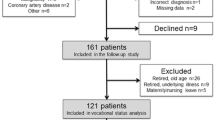Abstract
Severe cerebral venous thrombosis (CVT) is a rare cerebrovascular condition which in the more severe cases warrants intensive care treatment. While the outcome in the majority of uncomplicated CVT cases is good, it may be fatal in more affected patients. We provide long-term functional and quality of life (QOL) outcome data in the form of a retrospective analysis of 10 patients admitted to a neurological ICU with severe CVT. Outcome measures used were the modified Rankin Scale, the 36-item Short Form Health Survey, and the Psychological General Well-Being index. The mortality rate was 50% but 4 out 5 survivors had a good functional outcome with normal QOL despite a very severe clinical course. This finding justifies extensive life-sustaining therapy as the prognosis even of severe cases may be good if the acute phase is survived.
Similar content being viewed by others
References
Bergui M, Bradac GB, Daniele D (1999) Brain lesions due to cerebral venous thrombosis do not correlate with sinus involvement. Neuroradiology 41:419–424
Biousse V, Ameri A, Bousser MG (1999) Isolated intracranial hypertension as the only sign of cerebral venous thrombosis. Neurology 53:1537–1542
Breteau G, Mounier-Vehier F, Godefroy O, Gauvrit JY, Mackowiak-Cordoliani MA, Girot M, Bertheloot D, Henon H, Lucas C, Leclerc X, Fourrier F, Pruvo JP, Leys D (2003) Cerebral venous thrombosis 3-year clinical outcome in 55 consecutive patients. J Neurol 250:29–35
Cakmak S, Derex L, Berruyer M, Nighoghossian N, Philippeau F, Adeleine P, Hermier M, Froment JC, Trouillas P (2003) Cerebral venous thrombosis: clinical outcome and systematic screening of prothrombotic factors. Neurology 60:1175–1178
Canhao P, Ferro JM, Lindgren AG, Bousser MG, Stam J, Barinagarrementeria F; ISCVT Investigators (2005) Causes and predictors of death in cerebral venous thrombosis. Stroke 36:1720–1725
de Bruijn SF, Budde M, Teunisse S, de Haan RJ, Stam J. (2000) Long-term outcome of cognition and functional health after cerebral venous sinus thrombosis. Neurology 54:1687–1689
de Bruijn SF, de Haan RJ, Stam J for the Cerebral Venous Sinus Thrombosis Study Group (2001) Clinical features and prognostic factors of cerebral venous sinus thrombosis in a prospective series of 59 patients. J Neurol Neurosurg Psychiatry 70:105–108
Dupuy HJ (1984) The psychological general well-being index. In: Wenger Neal (ed) Assessment of quality of life in clinical trials of cardiovascular therapies. LeJacq Publishing, Darien, USA pp:170–183
Ferro JM, Lopes MG, Rosas MJ, Ferro MA, Fontes J for the Cerebral Venous Thrombosis Portuguese Collaborative Study Group (2002) Long-Term Prognosis of Cerebral Vein and Dural Sinus Thrombosis. Cerebrovasc Dis 13:272–278
Ferro JM, Canhao P, Stam J, Bousser MG, Barinagarrementeria F; ISCVT Investigators. (2004) Prognosis of cerebral vein and dural sinus thrombosis: results of the International Study on Cerebral Vein and Dural Sinus Thrombosis (ISCVT). Stroke 35:664–670
Fries G, Wallenfang T, Hennen J, Velthaus M, Heimann A, Schild H, Perneczky A, Kempski O (1992) Occlusion of the pig superior sagittal sinus, bridging and cortical veins: multistep evolution of sinus-vein thrombosis. J Neurosurg 77:127–133
Gotoh M, Ohmoto T, Kuyama H (1993) Experimental study of venous circulatory disturbance by dural sinus occlusion. Acta Neurochir (Wien) 124:120–126
Keller E, Pangalu A, Fandino J, Konu D, Yonekawa Y. (2005) Decompressive craniectomy in severe cerebral venous and dural sinus thrombosis. Acta Neurochir Suppl (Wien) 94:177–183
Masuhr F, Mehraein S (2004) Cerebral venous and sinus thrombosis: patients with a fatal outcome during intravenous dose-adjusted heparin treatment. Neurocrit Care 1:355–362
Preter M, Tzourio C, Ameri A, Bousser MG (1996) Long-Term Prognosis in Cerebral Venous Thrombosis. Stroke 27:243–246
Rother J, Waggie K, van Bruggen N, de Crespigny AJ, Moseley ME (1996) Experimental cerebral venous thrombosis: evaluation using magnetic resonance imaging. J Cereb Blood Flow Metab 16:1353–1361
Stolz E, Trittmacher S, Rahimi A, Gerriets T, Rottger C, Siekmann R, Kaps M (2004) Influence of recanalization on outcome in dural sinus thrombosis: a prospective study. Stroke 35:544–547
Strupp M, Covi M, Seelos K, Dichgans M, Brandt T (2002) Cerebral venous thrombosis: correlation between recanalization and clinical outcome–a long-term follow-up of 40 patients. J Neurol 249:1123–1124
Author information
Authors and Affiliations
Corresponding author
Additional information
A. Bender and G. Schulte-Altedorneburg contributed equally.
Rights and permissions
About this article
Cite this article
Bender, A., Schulte-Altedorneburg, G., Mayer, T.E. et al. Functional outcome after severe cerebral venous thrombosis. J Neurol 254, 465–470 (2007). https://doi.org/10.1007/s00415-006-0391-9
Received:
Revised:
Accepted:
Published:
Issue Date:
DOI: https://doi.org/10.1007/s00415-006-0391-9




